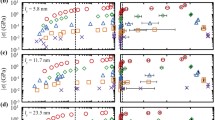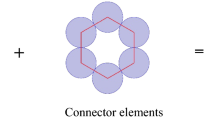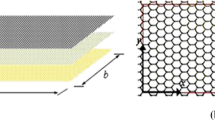Abstract
Double-layer graphene nanoribbons promise potential application in nanoelectromechanical systems and optoelectronic devices, and knowledge about mechanical stability is a crucial parameter to flourish the application of these materials at the next generation of nanodevices. In this paper, molecular mechanics is utilized to investigate nonlinear buckling behavior, critical buckling stress, and lateral deflection of double-layered graphene nanoribbons under various configurations of stacking mode and chirality. The implicit arc-length iterative method (modified Riks method) with Ramm’s algorithm is utilized to analyze the nonlinear structural stability problem. The covalent bonds are modeled using three-dimensional beam elements in which elastic moduli are calculated based on molecular structural mechanics technique, and the interlayer van der Waals (vdW) interactions are modeled with nonlinear truss elements. An analytical expression for Young’s modulus of nonlinear truss elements is derived based on the Lennard–Jones potential function and implemented in numerical simulation with a UMAT subroutine based on FORTRAN code to capture the nonlinearity of the vdW interactions during the buckling analysis. The results indicate that the highest critical buckling stress and the minimum lateral deflection occur for armchair and zigzag chirality, both with AB stacking mode, respectively. Moreover, the critical buckling stress is found to be directly dependent on the mode shape number regardless of in-phase or anti-phase deflection direction of layers. Lateral deflection exhibits a similar trend with mode shape in anti-phase mode; however, it is decreasing by increasing mode shape number in in-phase mode.














Similar content being viewed by others
References
Prabhu SA, Kavithayeni V, Suganthy R, Geetha K (2020) Graphene quantum dots synthesis and energy application: a review. Carbon Lett. https://doi.org/10.1007/s42823-020-00154-w
Sahoo SK, Mallik A (2019) Fundamentals of fascinating graphene nanosheets: a comprehensive study. Nano 14(3):1930003. https://doi.org/10.1142/S1793292019300032
Novoselov KS, Geim AK, Morozov SV, Jiang D, Zhang Y, Dubonos SV et al (2004) Electric field effect in atomically thin carbon films. Science 306(5696):666–669
Jung HY, Kim YR, Jeong HT (2020) All-solid-state supercapacitor composed of reduced graphene oxide (rGO)/activated carbon (AC) composite and polymer electrolyte. Carbon Lett 30(1):107–113
Lee C, Wei X, Kysar JW, Hone J (2008) Measurement of the elastic properties and intrinsic strength of monolayer graphene. Science 321(5887):385–388
Ebrahimi F, Dabbagh A (2018) Effect of humid-thermal environment on wave dispersion characteristics of single-layered graphene sheets. Appl Phys A 124(4):301
Reunchan P, Jhi S-H (2011) Metal-dispersed porous graphene for hydrogen storage. Appl Phys Lett 98(9):093103
Kim G, Jhi S-H, Lim S, Park N (2009) Effect of vacancy defects in graphene on metal anchoring and hydrogen adsorption. Appl Phys Lett 94(17):173102
Dai G, Liu J, Qian H (2019) CO catalytic oxidation over graphene with double vacancy-embedded molybdenum: a DFT investigation. Carbon Lett 29(4):337–344
Li J, Li J, Zhang H, Li T, Xiao J (2020) Structural characteristics and sodium penetration behaviors in anthracite cathodes: a combination study using Monte Carlo and molecular dynamics simulations. Carbon Lett 30(3):259–269
Nguyen HT (2019) Graphene layer of hybrid graphene/hexagonal boron nitride model upon heating. Carbon Lett 29(5):521–528
Galashev AY, Katin KP, Maslov MM (2019) Morse parameters for the interaction of metals with graphene and silicene. Phys Lett A 383(2–3):252–258
Gajbhiye SO, Singh S (2016) Nonlinear dynamics of bi-layered graphene sheet, double-walled carbon nanotube and nanotube bundle. Appl Phys A 122(5):523
Overney G, Zhong W, Tomanek D (1993) Structural rigidity and low frequency vibrational modes of long carbon tubules. Zeitschrift für Physik D Atoms Mol Clust 27(1):93–96
Lu JP (1997) Elastic properties of carbon nanotubes and nanoropes. Phys Rev Lett 79(7):1297
Kamali K, Nazemnezhad R (2018) Interlayer influences between double-layer graphene nanoribbons (shear and tensile-compressive) on free vibration using nonlocal elasticity theory. Mech Adv Mater Struct 25(3):225–237
Hosseini-Hashemi S, Sharifpour F, Ilkhani M (2016) On the free vibrations of size-dependent closed micro/nano-spherical shell based on the modified couple stress theory. Int J Mech Sci. 115:501–515
Javanbakht M, Ghaedi MS (2020) Nanovoid induced martensitic growth under uniaxial stress: effect of misfit strain, temperature and nanovoid size on PT threshold stress and nanostructure in NiAl. Comput Mater Sci 184:109928
Levitas VI, Jafarzadeh H, Farrahi GH, Javanbakht M (2018) Thermodynamically consistent and scale-dependent phase field approach for crack propagation allowing for surface stresses. Int J Plast 111:1–35
Jafarzadeh H, Levitas VI, Farrahi GH, Javanbakht M (2019) Phase field approach for nanoscale interactions between crack propagation and phase transformation. Nanoscale 11(46):22243–22247
Auffray N, dell’Isola F, Eremeyev VA, Madeo A, Rosi G (2015) Analytical continuum mechanics à la Hamilton-Piola least action principle for second gradient continua and capillary fluids. Math Mech Solids 20(4):375–417
Abali BE, Müller WH, dell’Isola F (2017) Theory and computation of higher gradient elasticity theories based on action principles. Arch Appl Mech 87(9):1495–1510
dell’Isola F, Seppecher P, Spagnuolo M, Barchiesi E, Hild F, Lekszycki T et al (2019) Advances in pantographic structures: design, manufacturing, models, experiments and image analyses. Continuum Mech Thermodyn 31(4):1231–1282
Dell’Isola F, Seppecher P, Alibert JJ, Lekszycki T, Grygoruk R, Pawlikowski M et al (2019) Pantographic metamaterials: an example of mathematically driven design and of its technological challenges. Continuum Mech Thermodyn 31(4):851–884
Peddieson J, Buchanan GR, McNitt RP (2003) Application of nonlocal continuum models to nanotechnology. Int J Eng Sci 41(3–5):305–312
Duan W, Wang CM (2007) Exact solutions for axisymmetric bending of micro/nanoscale circular plates based on nonlocal plate theory. Nanotechnology 18(38):385704
Pradhan S, Phadikar J (2010) Scale effect and buckling analysis of multilayered graphene sheets based on nonlocal continuum mechanics. J Comput Theor Nanosci 7(10):1948–1954
Ansari R, Shahabodini A, Rouhi H (2013) Prediction of the biaxial buckling and vibration behavior of graphene via a nonlocal atomistic-based plate theory. Compos Struct 95:88–94
Ansari R, Shahabodini A, Rouhi H (2015) A nonlocal plate model incorporating interatomic potentials for vibrations of graphene with arbitrary edge conditions. Curr Appl Phys 15(9):1062–1069
Jiang RW, Shen ZB, Tang GJ (2017) A semi-analytical method for nonlocal buckling and vibration of a single-layered graphene sheet nanomechanical resonator subjected to initial in-plane loads. Acta Mech 228(5):1725–1734
Shahabodini A, Ansari R, Darvizeh M (2017) Multiscale modeling of embedded graphene sheets based on the higher-order Cauchy-Born rule: nonlinear static analysis. Compos Struct 165:25–43
Lin F, Xiang Y, Shen H-S (2015) Buckling of graphene embedded in polymer matrix under compression. Int J Struct Stab Dyn 15(07):1540016
Hwu C, Yeh Y-K (2014) Explicit expressions of mechanical properties for graphene sheets and carbon nanotubes via a molecular-continuum model. Appl Phys A 116(1):125–140
Chang I-L, Chen J-A (2015) The molecular mechanics study on mechanical properties of graphene and graphite. Appl Phys A 119(1):265–274
Alizadeh O, Mohammadi S (2019) The variable node multiscale approach: coupling the atomistic and continuum scales. Comput Mater Sci 160:256–274
Turco E, Dell’Isola F, Cazzani A, Rizzi NL (2016) Hencky-type discrete model for pantographic structures: numerical comparison with second gradient continuum models. Z Angew Math Phys 67(4):85
Rahali Y, Giorgio I, Ganghoffer J, dell’Isola F (2015) Homogenization à la Piola produces second gradient continuum models for linear pantographic lattices. Int J Eng Sci 97:148–172
Giorgio I, Rizzi NL, Andreaus U, Steigmann DJ (2019) A two-dimensional continuum model of pantographic sheets moving in a 3D space and accounting for the offset and relative rotations of the fibers. Math Mech Complex Syst 7(4):311–325
Giorgio I, Rizzi N, Turco E (2017) Continuum modelling of pantographic sheets for out-of-plane bifurcation and vibrational analysis. Proc R Soc A Math Phys Eng Sci 473(2207):20170636
Giorgio I, Della Corte A, Dell’Isola F, Steigmann DJ (2016) Buckling modes in pantographic lattices. CR Mec 344(7):487–501
Dell’Isola F, Della Corte A, Greco L, Luongo A (2016) Plane bias extension test for a continuum with two inextensible families of fibers: a variational treatment with Lagrange multipliers and a perturbation solution. Int J Solids Struct 81:1–12
Tserpes KI, Papanikos P (2014) Finite element modeling of the tensile behavior of carbon nanotubes, graphene and their composites Modeling of carbon nanotubes, graphene and their composites. Springer, Berlin, pp 303–329
Giannopoulos G, Tsiros A, Georgantzinos S (2013) Prediction of elastic mechanical behavior and stability of single-walled carbon nanotubes using bar elements. Mech Adv Mater Struct 20(9):730–741
Allinger NL, Yuh YH, Lii JH (1989) Molecular mechanics. The MM3 force field for hydrocarbons. J Am Chem Soc 111(23):8551–8566
Korobeynikov S, Alyokhin V, Babichev A (2018) Simulation of mechanical parameters of graphene using the DREIDING force field. Acta Mech 229(6):2343–2378
Mayo SL, Olafson BD, Goddard WA (1990) DREIDING: a generic force field for molecular simulations. J Phys Chem 94(26):8897–8909
Turco E, Barchiesi E, Giorgio I, dell’Isola F (2020) A Lagrangian Hencky-type nonlinear model suitable for metamaterials design of shearable and extensible slender deformable bodies alternative to Timoshenko theory. Int J Nonlinear Mech 123:103481
Turco E, Barchiesi E (2019) Equilibrium paths of Hencky pantographic beams in a three-point bending problem. Math Mech Complex Syst 7(4):287–310
Turco E (2018) In-plane shear loading of granular membranes modeled as a Lagrangian assembly of rotating elastic particles. Mech Res Commun 92:61–66
Meo M, Rossi M (2006) Prediction of Young’s modulus of single wall carbon nanotubes by molecular-mechanics based finite element modelling. Compos Sci Technol 66(11–12):1597–1605
Tserpes K, Papanikos P (2005) Finite element modeling of single-walled carbon nanotubes. Compos B Eng 36(5):468–477
Li C, Chou T-W (2003) A structural mechanics approach for the analysis of carbon nanotubes. Int J Solids Struct 40(10):2487–2499
Li C, Chou T-W (2003) Elastic moduli of multi-walled carbon nanotubes and the effect of van der Waals forces. Compos Sci Technol 63(11):1517–1524
Huang M-Y, Chen H-B, Lu J-N, Lu P, Zhang P-Q (2013) A modified molecular structural mechanics method for analysis of carbon nanotubes. Chin J Chem Phys. 19(4):286
Eberhardt O, Wallmersperger T (2015) Energy consistent modified molecular structural mechanics model for the determination of the elastic properties of single wall carbon nanotubes. Carbon 95:166–180
Singh S, Patel B (2015) Nonlinear elastic properties of graphene sheet under finite deformation. Compos Struct 119:412–421
Kumar A, Sharma K, Dixit AR (2020) A review on the mechanical properties of polymer composites reinforced by carbon nanotubes and graphene. Carbon Lett. https://doi.org/10.1007/s42823-020-00161-x
Zhang X, Dong J, Gong X, Ding F (2018) The formation and stability of junctions in single-wall carbon nanotubes. Nanotechnology 29(48):485702
Shende P, Augustine S, Prabhakar B (2020) A review on graphene nanoribbons for advanced biomedical applications. Carbon Lett. 30:465–475. https://doi.org/10.1007/s42823-020-00125-1
Genoese A, Genoese A, Salerno G (2020) Buckling and post-buckling analysis of single wall carbon nanotubes using molecular mechanics. Appl Math Model 83:777–800
Genoese A, Genoese A, Rizzi NL, Salerno G (2019) On the in-plane failure and post-failure behaviour of pristine and perforated single-layer graphene sheets. Math Mech Solids 24(11):3418–3443
Eremeyev VA, Turco E (2020) Enriched buckling for beam-lattice metamaterials. Mech Res Commun 103:103458
Parashar A, Mertiny P (2012) Representative volume element to estimate buckling behavior of graphene/polymer nanocomposite. Nanoscale Res Lett 7(1):515
Rouhi S, Ansari R (2012) Atomistic finite element model for axial buckling and vibration analysis of single-layered graphene sheets. Phys E 44(4):764–772
Tserpes K, Vatistas I (2015) Buckling analysis of pristine and defected graphene. Mech Res Commun 64:50–56
Jung MW, Myung S, Kim KW, Song W, Jo Y-Y, Lee SS et al (2014) Fabrication of graphene-based flexible devices utilizing a soft lithographic patterning method. Nanotechnology 25(28):285302
Yu X, Cheng H, Zhang M, Zhao Y, Qu L, Shi G (2017) Graphene-based smart materials. Nat Rev Mater 2(9):17046
Sheng Y, Rong Y, He Z, Fan Y, Warner JH (2015) Uniformity of large-area bilayer graphene grown by chemical vapor deposition. Nanotechnology 26(39):395601
Rafiee MA, Lu W, Thomas AV, Zandiatashbar A, Rafiee J, Tour JM et al (2010) Graphene nanoribbon composites. ACS Nano 4(12):7415–7420
Neek-Amal M, Peeters F (2010) Defected graphene nanoribbons under axial compression. Appl Phys Lett 97(15):153118
Shi J-X, Ni Q-Q, Lei X-W, Natsuki T (2011) Nonlocal elasticity theory for the buckling of double-layer graphene nanoribbons based on a continuum model. Comput Mater Sci 50(11):3085–3090
Zhu Y, Murali S, Cai W, Li X, Suk JW, Potts JR et al (2010) Graphene and graphene oxide: synthesis, properties, and applications. Adv Mater 22(35):3906–3924
Leenaerts O, Partoens B, Peeters F (2013) Tunable double dirac cone spectrum in bilayer α-graphyne. Appl Phys Lett 103(1):013105
Rafiee R, Eskandariyun A (2017) Comparative study on predicting Young’s modulus of graphene sheets using nano-scale continuum mechanics approach. Phys E 90:42–48
Cornell WD, Cieplak P, Bayly CI, Gould IR, Merz KM, Ferguson DM et al (1995) A second generation force field for the simulation of proteins, nucleic acids, and organic molecules. J Am Chem Soc 117(19):5179–5197
Nye JF (1985) Physical properties of crystals: their representation by tensors and matrices. Oxford University Press, Oxford
Kim JH, Jeong JH, Kim N, Joshi R, Lee G-H (2018) Mechanical properties of two-dimensional materials and their applications. J Phys D Appl Phys 52(8):083001
Wan K-T, Guo S, Dillard DA (2003) A theoretical and numerical study of a thin clamped circular film under an external load in the presence of a tensile residual stress. Thin Solid Films 425(1–2):150–162
Blakslee O, Proctor D, Seldin E, Spence G, Weng T (1970) Elastic constants of compression-annealed pyrolytic graphite. J Appl Phys 41(8):3373–3382
Kordkheili SH, Moshrefzadeh-Sani H (2013) Mechanical properties of double-layered graphene sheets. Comput Mater Sci 69:335–343
Saito R, Matsuo R, Kimura T, Dresselhaus G, Dresselhaus M (2001) Anomalous potential barrier of double-wall carbon nanotube. Chem Phys Lett 348(3–4):187–193
Scarpa F, Adhikari S, Chowdhury R (2010) The transverse elasticity of bilayer graphene. Phys Lett A 374(19–20):2053–2057
Namnabat MS, Barzegar A, Javanbakht M (2019) Finite element buckling analysis of double-layered graphene nanoribbons. Mater Res Express 6(5):055023
ABAQUS IJV (2014) Abaqus documentation, vol 6, pp 5–1
Krenk S (2009) Nonlinear modeling and analysis of solids and structures. Cambridge University Press, Cambridge
Hang Y, Wen-Zhi W, Yu J, Guo W-L (2015) Tuning the energy gap of bilayer α-graphyne by applying strain and electric field. Chin Phys B 25(2):023102
Farajpour A, Solghar AA, Shahidi A (2013) Postbuckling analysis of multi-layered graphene sheets under non-uniform biaxial compression. Phys E 47:197–206
Author information
Authors and Affiliations
Corresponding author
Ethics declarations
Conflict of interest
On behalf of all authors, the corresponding author states that there is no conflict of interest.
Additional information
Publisher's Note
Springer Nature remains neutral with regard to jurisdictional claims in published maps and institutional affiliations.
Rights and permissions
About this article
Cite this article
Namnabat, M.S., Barzegar, A., Barchiesi, E. et al. Nonlinear buckling analysis of double-layered graphene nanoribbons based on molecular mechanics. Carbon Lett. 31, 895–910 (2021). https://doi.org/10.1007/s42823-020-00194-2
Received:
Revised:
Accepted:
Published:
Issue Date:
DOI: https://doi.org/10.1007/s42823-020-00194-2




